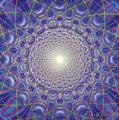
DMT-Nexus member

Posts: 3090 Joined: 09-Jul-2016 Last visit: 03-Feb-2024
|
In a recent podcast, the psychedelic researcher hamilton morris talks about enantiopure MDA. Apparently, with psychedelic amphetamines, there is usually a psychedelic enantiomer and a non or less psychedelic one. This made me wonder...would this also be the case with psychedelic phenethylamines in general? Would it be worthwile to try to enantiomerically purify 2C-B? Or better even...what about mescaline? Imagine you could make mescaline even better than it already is  The idea is to use an enantiomerically pure acid to create a salt. Then to use the solvabillity of that salt to separate it.
|
|
|
|
|

DMT-Nexus member

Posts: 14191 Joined: 19-Feb-2008 Last visit: 22-Nov-2025 Location: Jungle
|
Not all phenetylamines have enantiomers because not all of them have a chiral center where you could rotate the molecule and get a mirror image of it.
Mescaline for example doesn't, neither does 2CB.
|
|
|

DMT-Nexus member

Posts: 823 Joined: 23-Sep-2017 Last visit: 05-Feb-2024
|
Actually only Amphetamines are chiral - exactly this alpha-methyl makes them chiral. Basically all other sites are either never used for creating isomers (no beta-methyl) and even the sp3 (means a mode of 4 bonds possible) amine will never be truly chiral with 4 different substitutents, because amines inverse into each other permanently  Still interesting that some of the first ones are more / less potent. I knew only from that classic example (s)-Ketamin which is neither PEA nor Amphetamin 
|
|
|

DMT-Nexus member

Posts: 3090 Joined: 09-Jul-2016 Last visit: 03-Feb-2024
|
OK, i thought it was just a matter of asymmetry. Good to have some real chemists around.
What do you think would be some good candidates for enantiomeric purification?
|
|
|

DMT-Nexus member

Posts: 14191 Joined: 19-Feb-2008 Last visit: 22-Nov-2025 Location: Jungle
|
Brennendes Wasser wrote:Actually only Amphetamines are chiral - exactly this alpha-methyl makes them chiral. Basically all other sites are either never used for creating isomers (no beta-methyl) and even the sp3 (means a mode of 4 bonds possible) amine will never be truly chiral with 4 different substitutents, because amines inverse into each other permanently  Still interesting that some of the first ones are more / less potent. I knew only from that classic example (s)-Ketamin which is neither nor  But why only amphetamines? You could have a number of substituents/functional groups at the alpha or beta position that would be a chiral center, or even a group sticking out of the benzene ring with a chiral center like 2CT17 , right?
|
|
|

DMT-Nexus member

Posts: 823 Joined: 23-Sep-2017 Last visit: 05-Feb-2024
|
Quote:But why only amphetamines? You could have a number of substituents/functional groups at the alpha or beta position that would be a chiral center, no? Yes absolutely but if you would alpha-substitute it then you again get an Amphetamin. Or at least a derivate, if you use ethyl, propyl, ... so this would then count again for being an Amphetamin example. And indeed beta substitutions would make them also chiral, rendering them something like a new group of BM-phetamines (or derivates with Ethyl, ...). But that has never hit the market, probably as beta-position is not effective at shielding the Amine against enzymes. The using some harder to find precursor will not grant a stronger drug therefore and therefore was not realized (in big scales at least) till now. So this category also falls short. Substitutents at the ring system never induce chirality, as the corresponding C-atom is in a sp2-state, being also planar and not tetraedric. So more from a practical point of view you will not encounter any chiral PEAs in the black market. Then again this amine could be 'chiral' with 4 different substitutens: Imagine a Mescalin with Ethyl + Isopropyl substitutent at the N. It would be chiral, but tertiary amines permanently switch between a sp3 and sp2 state, meaning they can also have a geometry which is planar / flat. During this short transition state it is completely random if it will then revert back into (S) or (R). Therefore 3° amines are not counted as chiral due to fast inversion into each other, even though they could have 4 different substitutents. Quote:What do you think would be some good candidates for enantiomeric purification? Well as I did not even knew that PEAs have enantiomer-related different activities no idea, but in general separation is quite hard and even pharmaceutical companies quite often prefer to just leave that inactive stuff inside  I guess if it just has twice the effect then I'd prefer to just take the double amount  Might be only an issue if any lesser psychedelic has even contrary effects?
|
|
|

DMT-Nexus member

Posts: 14191 Joined: 19-Feb-2008 Last visit: 22-Nov-2025 Location: Jungle
|
Brennendes Wasser wrote:Quote:But why only amphetamines? You could have a number of substituents/functional groups at the alpha or beta position that would be a chiral center, no? Yes absolutely but if you would alpha-substitute it then you again get an Amphetamin. Or at least a derivate, if you use ethyl, propyl, ... so this would then count again for being an Amphetamin example. And indeed beta substitutions would make them also chiral, rendering them something like a new group of BM-phetamines (or derivates with Ethyl, ...). But that has never hit the market, probably as beta-position is not effective at shielding the Amine against enzymes. So this category also falls short. Substitutents at the ring system never induce chirality, as the corresponding C-atom is in a sp2-state, being also planar and not tetraedric. So more from a practical point of view you will not encounter any chiral PEAs in the black market. Then again this amine could be 'chiral' with 4 different substitutens: Imagine a Mescalin with Ethyl + Isopropyl substitutent at the N. It would be chiral, but tertiary amines permanently switch between a sp3 and sp2 state, meaning they can also have a geometry which is planar / flat. During this short transition state it is completely random if it will then revert back into (S) or (R). Therefore 3° amines are not counted as chiral due to fast inversion into each other, even though they could have 4 different substitutents. I made an edit in my previous post as you were writing your post, but you could also have longer substiuents off the benzene ring with a chiral center, like 2CT17 right? This page is an interesting resource to visualize some of the possibilities, many of which have been bioassayed: https://isomerdesign.com...KAL/browse.php?domain=pk
|
|
|

DMT-Nexus member

Posts: 823 Joined: 23-Sep-2017 Last visit: 05-Feb-2024
|
Quote:I made an edit in my previous post, you could also have longer substiuents off the benzene ring with a chiral center, like 2CT17 True so these carbons could indeed be chiral again. The only restriction now to the topic of more/less potent/psychedelic compounds would be as follows: Any modification at a side chain like this will most likely not have any effect on the Pharmacophore of the drug. That thing is basically just the bare required molecule skeleton that is needed to get the desired receptor interaction. As in case of PEAs this one is most probably mostly mediated around the Benzyl group + the flexible amine at the end of the chain, the most direct effect between enantiomers which I would expect might come from playing around in exactly that area. Choosing / changing / alternating any substitutents that are quite distant from that Pharmacophore might instead have more effects on drug absorption / pharmacokinetiks than on actual receptor binding.
|
|
|

DMT-Nexus member

Posts: 3090 Joined: 09-Jul-2016 Last visit: 03-Feb-2024
|
Brennendes Wasser wrote:Quote:What do you think would be some good candidates for enantiomeric purification? Well as I did not even knew that PEAs have enantiomer-related different activities no idea, but in general separation is quite hard and even pharmaceutical companies quite often prefer to just leave that inactive stuff inside  I guess if it just has twice the effect then I'd prefer to just take the double amount  Might be only an issue if any lesser psychedelic has even contrary effects? From what i understood, listening to the podcast, the process itself is not that difficult. It just has to be repeated a dozen or more times, because there is a slight difference in solubility when you use an enantiopure acid to make a salt. So tedious, yes. But not realy hard to do.
|
|
|

DMT-Nexus member

Posts: 823 Joined: 23-Sep-2017 Last visit: 05-Feb-2024
|
That would maybe indeed not be too difficoult, but I'm just thinking that as an example (D) tartaric acid would drop both (D) DOB and (L) DOB from solution. Maybe crystal lattice is different, but not sure why it would form only 1 of the 2 possibilities in the first place? Maybe there are some cases of solvents which might still prefer one. Would be then called anisotropic solvent, as it prefers one direction over another and is not isotropic - a state where characteristics are unbound from any direction. Liquid crystals may exhibit this aligning effects. And in big scale pharma the compounds are often run through a column with a chiral package - interacting stronger with one enantiomer. Because that package needs to be well adjusted to any new compound it is quite money-consuming. Maybe the authors means something way simpler and therefore needs to be done at a multitude, but if it's worth the hassle then there will always be somebody doing it 
|
|
|

Boundary condition

Posts: 8617 Joined: 30-Aug-2008 Last visit: 29-Nov-2025 Location: square root of minus one
|
One way of having an ever-so-slightly chiral phenethylamine [not an amphetamine], asides from using a chiral 4-substituent as in the case exemplified by 2C-T-17, would be to deuterate singly at the alpha carbon. This would be decidedly difficult to obtain in an enantiomerically pure state, but it most likely would involve the asymmetric deuteration of an imine using a chiral catalyst. Using a chiral alpha-methylbenzylamine to form the imine, followed by its removal via catalytic hydrogenation would be a relatively common procedure in this respect which would improve the enantiomer ratio. Whether asymmetric alpha-deuteration would produce any perceptible difference in subjective effects is highly debatable. Brennendes Wasser wrote:(D) tartaric acid would drop both (D) DOB and (L) DOB from solution. Maybe crystal lattice is different, but not sure why it would form only 1 of the 2 possibilities in the first place? but the lattice energies of the two enantiomeric tartrates are different. This means one form will be less soluble than the other and will preferentially crystallise. Or you could do like Pasteur and separate the crystals by hand, using tweezers and a magnifying glass  Quote:I guess if it just has twice the effect then I'd prefer to just take the double amount  Might be only an issue if any lesser psychedelic has even contrary effects? One famous example here is that of thalidomide (Contergan to you, BW). The less active enantiomer might have negative or even damaging effects. Examination of the enantiomers of MDMA proved quite interesting. As you may know, with this one the active isomer follows the pattern of stimulant amphetamines rather than psychedelic ones - probably since it is a neurotransmitter releasing agent rather than a receptor agonist. All the same, the impression given by the reports in part II of PIHKaL is that most people would still prefer the racemate. Perhaps this has something to do with the significant proportion of MDA that is formed by metabolic demethylation. Quote:Maybe there are some cases of solvents which might still prefer one. Would be then called anisotropic solvent, as it prefers one direction over another and is not isotropic - a state where characteristics are unbound from any direction. Liquid crystals may exhibit this aligning effects. It's quite conceivable that by using enantiomerically pure 2-butanol, for example, there might be an observable effect on enantiomeric balance in chiral synthesis. There are probably examples of this in the literature. Brownie points for the first person to dig one out. Chiral packing substrate in preparative chromatography is definitely a thing too - and way more effective than a chiral solvent “There is a way of manipulating matter and energy so as to produce what modern scientists call 'a field of force'. The field acts on the observer and puts him in a privileged position vis-à-vis the universe. From this position he has access to the realities which are ordinarily hidden from us by time and space, matter and energy. This is what we call the Great Work." ― Jacques Bergier, quoting Fulcanelli
|